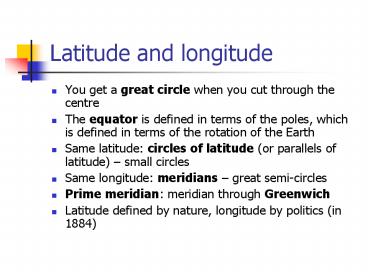Latitude and longitude - PowerPoint PPT Presentation
1 / 15
Title:
Latitude and longitude
Description:
Tropic of Cancer, lat = 23.5 N. Northern part of the tropics, 0 N lat 23.5 ... Tropic of Capricorn, lat = 23.5 S. South temperate zone, 23.5 S lat 66.5 S ... – PowerPoint PPT presentation
Number of Views:441
Avg rating:3.0/5.0
Title: Latitude and longitude
1
Latitude and longitude
- You get a great circle when you cut through the
centre - The equator is defined in terms of the poles,
which is defined in terms of the rotation of the
Earth - Same latitude circles of latitude (or parallels
of latitude) small circles - Same longitude meridians great semi-circles
- Prime meridian meridian through Greenwich
- Latitude defined by nature, longitude by politics
(in 1884)
2
Angles
- Distances on a sphere are measured in degrees and
minutes and seconds of arc - 1 degree 60 min. of arc, 1 60
- 1 min. of arc 60 sec. of arc, 1 60
- 1 30 1.5
- The angle between two great circles is equal to
the maximal distance between them
3
Different parts of the Earth
- North Pole, lat 90N
- Arctic region lat gt 66.5N, midnight sun
- Arctic circle, lat 66.5N
- North temperate zone, 23.5N lt lat lt 66.5N
- Tropic of Cancer, lat 23.5N
- Northern part of the tropics, 0Nlt lat lt 23.5N,
Sun can be in zenith (directly overhead) - Equator, lat 0
4
Different parts of the Earth 2
- Southern part of the tropics, 0Slt lat lt 23.5S,
Sun can be in zenith (directly overhead) - Tropic of Capricorn, lat 23.5S
- South temperate zone, 23.5S lt lat lt 66.5S
- Antarctic circle, lat 66.5S
- Antarctic region lat gt 66.5S, midnight sun
- South Pole, lat 90S
- The tropics is the region between the Tropics
5
The Celestial Sphere
- Horizon great circle that separates the visible
part of the celestial sphere from the invisible
(local) - Can also think of it as the tangent plane of the
observer - The horizon circle is the intersection of the
horizon plane with the celestial sphere
6
Celestial Sphere 2
- North celestial pole (NCP) point directly above
the north pole (global) - North point point on the horizon straight north
(local) - Zenith point directly above (local)
- Nadir point directly below invisible (local)
7
Celestial Sphere 3
- Celestial equator great circle above the earths
equator (global) - (Celestial) meridian great circle through the
north point, zenith and the south point (local)
8
Celestial Sphere 4
9
Celestial Sphere 5
- Infinitely many meridians on the Earth only one
in the Sky - a.m. ante meridiem, p.m. post meridiem
10
Celestial Sphere 6
- Vertical circle great circle perpendicular to
the horizon - Prime vertical vertical circle through the west
point, zenith and the east point - Notice that the prime vertical and the meridian
intersect perpendicularly at the zenith
11
The Celestial Sphere 7
- The altitude (distance from the horizon) of the
NCP the latitude of the observer - If we use negative latitude for the southern
hemisphere, this formula holds there, too
12
The Celestial Sphere 8
- The angle between the celestial equator and the
southern part of the horizon 90 - the latitude
of the observer, which is called the colatitude - This also holds for the southern hemisphere,
where the colatitude is larger than 90
13
Motion of the Stars
- Stars move westward (across the visible part of
the celestial sphere) - The daily (diurnal) path of the stars are
parallel to the celestial equator - The stars cross the horizon at an angle equal to
the colatitude
14
Circumpolar Stars
- Circumpolar stars are stars that are so close to
the pole that they never set - In Singapore there are no circumpolar stars
- On the north pole, all stars are circumpolar
- A star is circumpolar if the distance from the
pole is less than the latitude
15
Circumpolar Stars 2
- For an observer on the northern hemisphere, stars
inside a disc around the NCP with radius equal to
the observers latitude will never set - Stars inside a disc around the SCP with radius
equal to the observers latitude will never rise - Stars in the middle will rise and set
- Circumpolar does not mean visible all the time a
star is only visible if the Sky is dark and it is
above the horizon































